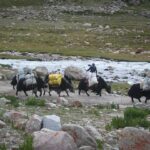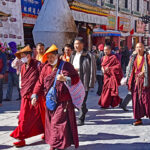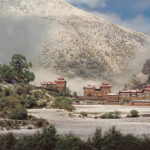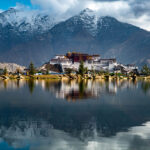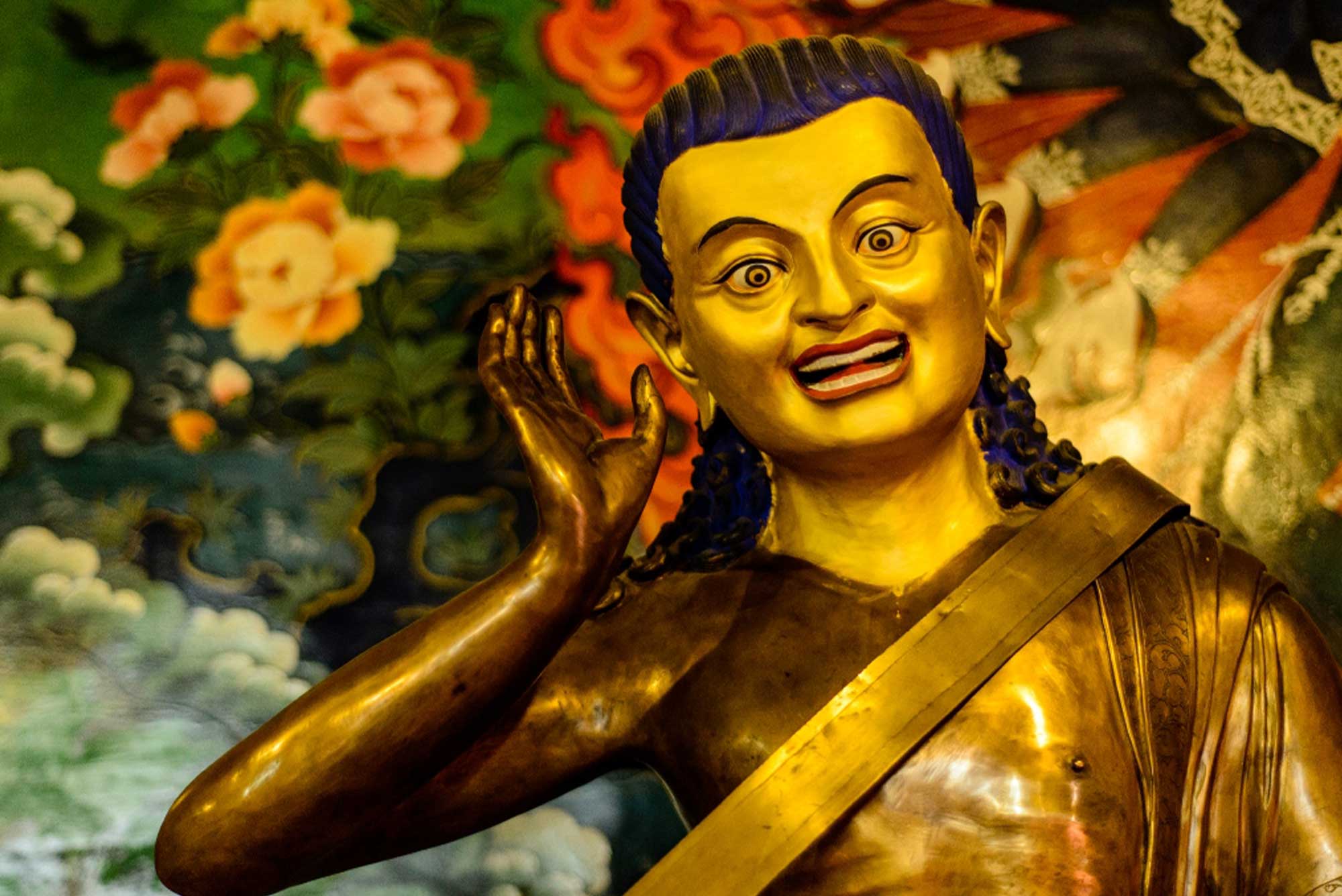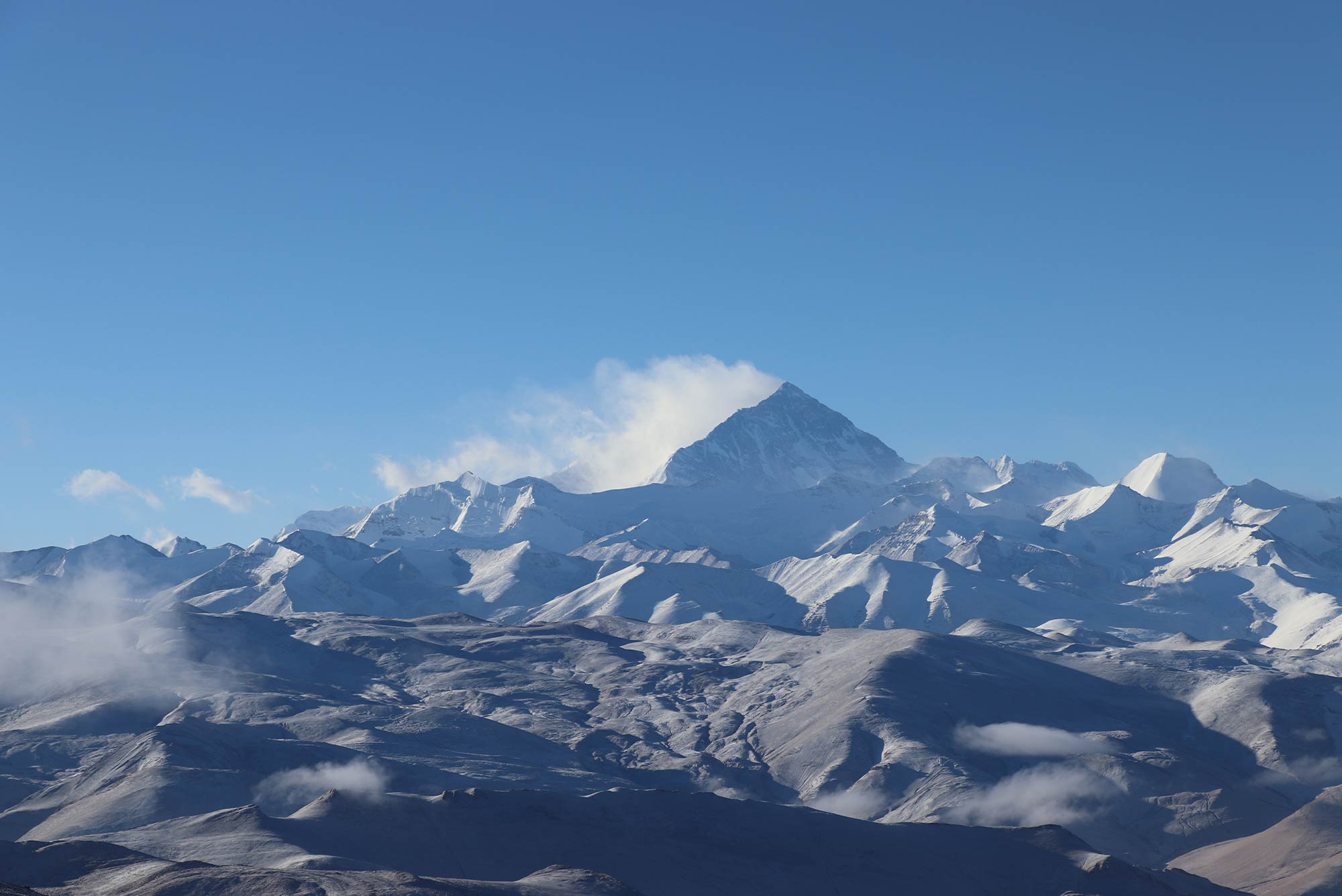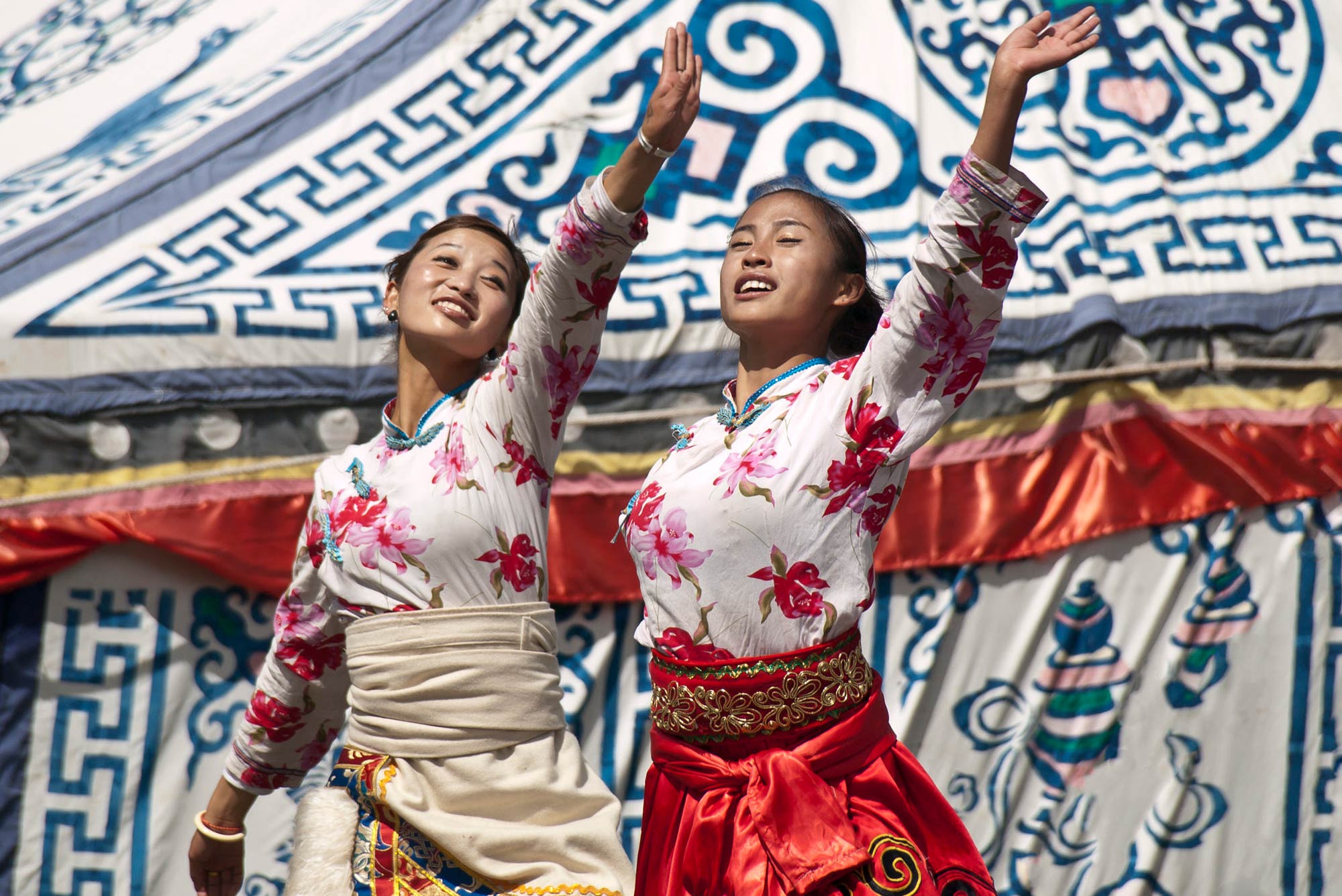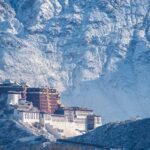The Sichuan Tibet Highway, often fondly referred to as the Chengdu-Lhasa Highway, is more than just a stretch of asphalt connecting two cities. It’s a testament to human engineering, a lifeline for the mystical region of Tibet, and an adventure waiting to be embraced. This iconic highway, strategically divided into two distinct routes, offers travelers not just a journey but an epic odyssey.
This article is your guide to the enchanting Southern and Northern Routes of the Sichuan Tibet Highway, where we’ll delve deep into not only the breathtaking landscapes but also the rich cultural experiences that define this incredible passage. As we traverse these roads, you’ll discover that it’s not just about the destination; it’s about the unforgettable journey. We’ll also share insights into the optimal times to embark on this road trip, ensuring you make the most of this adventure of a lifetime.
So, fasten your seatbelt and prepare for an extraordinary expedition as we embark on an exploration of the Southern and Northern Routes of the Sichuan Tibet Highway.
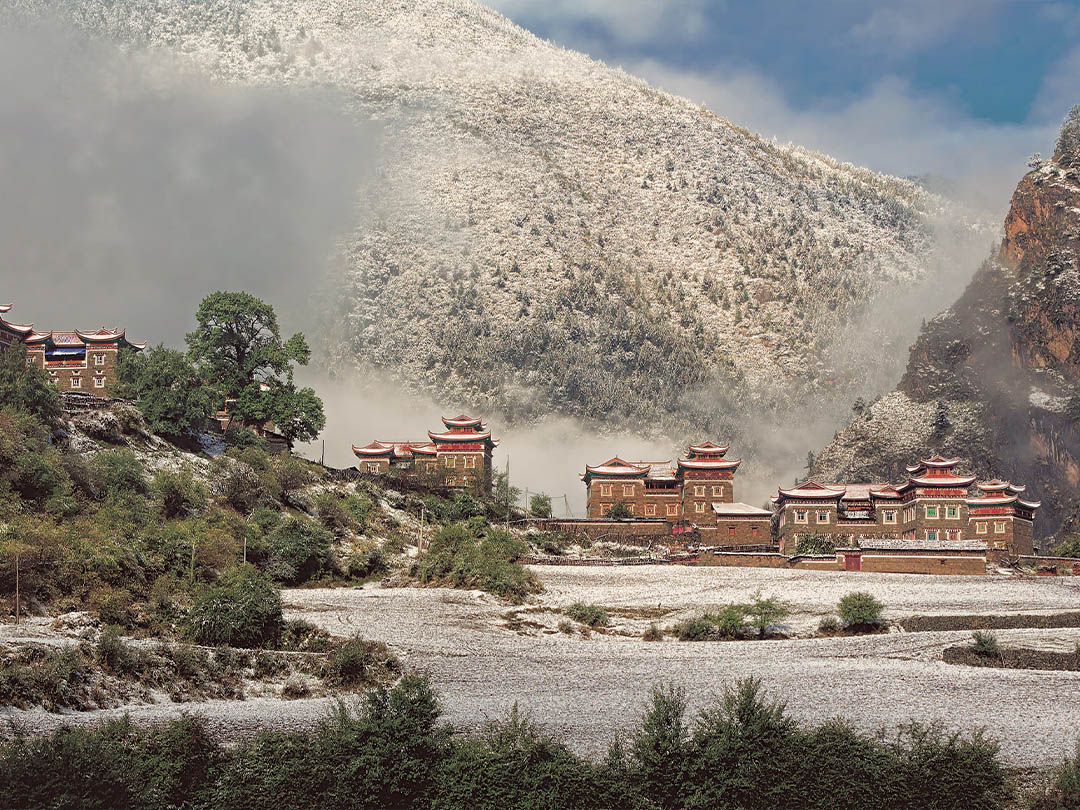
The Sichuan-Tibet Highway: A Marvel of Engineering
Inaugurated on a significant day, December 25, 1954, the Sichuan-Tibet Highway stands as a testament to human engineering and an emblem of progress for the mystical land of Tibet. It’s not just any road; it’s a lifeline that binds Eastern Tibet to the rest of the world. This highway, often referred to as the Chengdu-Lhasa Highway, is not merely an artery for vehicles but a symbol of economic development for the entire region.
Spanning from Chengdu, the bustling capital of Sichuan Province in the east, to the spiritual heart of Tibet, Lhasa, in the west, the Sichuan-Tibet Highway is a lifeline that breathes life into the rugged and remote landscapes it traverses. What makes this highway truly remarkable is its division into two distinct routes, each offering a unique and awe-inspiring travel experience.
The Southern Route and the Northern Route beckon adventure-seekers and cultural enthusiasts alike, promising an unforgettable journey filled with breathtaking vistas, rich traditions, and the spirit of exploration. These two routes aren’t just roads; they are gateways to a world where nature’s grandeur meets human ingenuity, where every turn reveals a new story, and where the journey is as significant as the destination.
In the following sections, we will embark on a comprehensive exploration of both the Southern and Northern Routes of the Sichuan-Tibet Highway, uncovering the treasures they hold and providing you with the insights you need to plan your own epic adventure along these captivating roads. So, fasten your seatbelt and get ready to journey through one of the most remarkable highway systems on our planet.
The Northern Route: A Cultural Exploration
Start from Chengdu: The Gateway to Adventure
Our epic journey commences in the bustling metropolis of Chengdu, where your adventure along the Sichuan-Tibet Highway begins. Chengdu, with its vibrant culture and mouthwatering Sichuan cuisine, serves as the perfect launchpad for what promises to be a road trip of a lifetime.
The Southern Route, spanning an impressive 2,149 kilometers, offers a captivating blend of natural beauty and cultural encounters. It’s not just a drive; it’s an expedition into a world where landscapes change like chapters in a book, and traditions are as enduring as the mountains that frame the horizon.
As you set out from Chengdu, the road ahead unfurls like a grand tapestry, promising countless wonders along the way. You’ll be immersed in a world where mountains vault skyward, rivers rush with purpose, and valleys beckon with their tranquility. This is where you’ll encounter the heartbeat of Eastern Tibet, and every twist and turn will reveal a piece of its soul.
In the upcoming sections, we’ll delve into the highlights of the Southern Route, from the majestic Erlang Mountain to the crystal blue waters of Ranwu Lake. Our journey will encompass the rich culture of the Tibetan Plateau, and every stop will be an opportunity to immerse yourself in the unique experiences this route has to offer.
So, fasten your seatbelt, rev up your engines, and get ready to embark on a journey that promises not only to be an expedition into nature’s finest creations but a cultural exploration of unparalleled depth. The Southern Route awaits, and the adventure begins in Chengdu.
Ya’an: The Gateway to Adventure
Our first pivotal stop on this remarkable journey is the city of Ya’an, and it’s more than just a place on the map. Ya’an is where the adventure takes a remarkable turn, as you transition from the familiar landscapes of Sichuan to the awe-inspiring terrain of the Tibetan Plateau.
As the gateway to the Sichuan-Tibet Highway, Ya’an holds a special place in the hearts of those embarking on this epic road trip. It’s a city with a unique charm, nestled at the foot of the mighty Hengduan Mountains, where nature’s grandeur is on full display.
From Ya’an, you’ll commence your ascent into the high-altitude regions that define the Tibetan Plateau. The roads wind upward, and the air grows crisper as you leave the lowlands behind. This transition marks the beginning of a transformational journey where the world changes around you, and you become a part of a new realm.
But Ya’an offers more than just a starting point. It’s a place to savor the beauty of the region, perhaps with a visit to Bifengxia Panda Base or a leisurely stroll along the picturesque banks of the Dadu River. You can enjoy a taste of Sichuan cuisine, renowned for its bold flavors and spicy dishes, which is the perfect culinary send-off as you venture into the heart of Tibet.
In the subsequent sections, we’ll explore the roads that lead from Ya’an to Kangding, where you’ll continue to be captivated by the stunning landscapes and local culture. Ya’an is just the beginning, but it’s a beginning filled with anticipation, as it signifies that you are on the threshold of an adventure like no other.
So, let Ya’an be the place where your journey truly begins, and the mysteries of the Sichuan-Tibet Highway unfurl before you.
Kangding – A Taste of Tibetan Culture
Our journey takes us to Kangding, a charming town that embodies the essence of Tibetan culture while surrounded by some of the most stunning landscapes you’ll ever encounter. Nestled in the heart of the Hengduan Mountains, Kangding is the ideal place to fully immerse yourself in the local traditions and experience the ever-changing beauty of this region.
As you arrive in Kangding, you’ll be greeted by a sense of tranquility that transcends the hustle and bustle of modern life. The town’s Tibetan heritage is immediately evident in its architecture, colorful prayer flags fluttering in the breeze, and the warm smiles of the locals who are eager to share their rich culture with visitors.
One of Kangding’s highlights is the opportunity to explore Tibetan monasteries like Nanwu Temple and Mugecuo Lake, where you can witness the deep-rooted spirituality of the region. Kangding is often referred to as the “Land of Kham” and offers a unique blend of Tibetan customs and the hospitality of its people.
This town serves as a gateway to the ever-changing scenery of the Tibetan Plateau. The transition from Kangding to higher altitudes takes you through a world that shifts from alpine forests to rugged mountains and then opens up into sweeping grasslands. Kangding is, in many ways, a microcosm of the diversity you’ll encounter on the Sichuan-Tibet Highway.
In the upcoming sections, we’ll delve into the local delicacies, the vibrant traditions, and the scenic wonders that await as you continue your journey from Kangding. This town is more than a stop along the way; it’s a cultural crossroads and a place to truly appreciate the magic of the Tibetan Plateau.
So, allow Kangding to be your doorway to the world of Tibetan culture and a prelude to the ever-changing scenery that lies ahead. Your adventure is just beginning, and Kangding is where it truly comes to life.
Litang: The Roof of the World
Our next destination, Litang, is not your typical town. It’s a high-altitude marvel often referred to as the “Roof of the World.” Here, you’ll be awed by the majestic mountains that surround you and the unique culture that flourishes at this lofty altitude.
Litang is perched on the eastern edge of the Tibetan Plateau, and as you arrive, the first thing that will capture your attention is the sheer height above sea level. Located at an elevation of around 4,014 meters (13,169 feet), Litang is one of the highest towns on the planet. The air is thin, and the landscape is starkly beautiful, making you feel like you’ve stepped into another world.
This high-altitude haven is known for its rugged beauty. The town itself is set against a backdrop of snow-capped peaks that seem to touch the heavens. The Kangri Garpo Range and the peaks of Chola and Gela Dondrup loom large, casting their shadows over the town.
Litang offers a unique blend of Tibetan culture. Here, you’ll encounter nomadic herders, visit historic monasteries like Litang Chode Gompa, and witness traditional Tibetan festivals. The local people are warm and welcoming, eager to share their customs and stories.
The journey from Kangding to Litang is one of transformation. As you ascend higher into the mountains, you’ll notice the landscape shift from alpine forests to wide, open grasslands where yaks graze peacefully. Litang is a place where time seems to stand still, allowing you to savor the simplicity of life in this high-altitude haven.
In the upcoming sections, we’ll explore Litang’s unique traditions, the vibrant nomadic culture, and the breathtaking panoramas that await as you continue your journey. Litang is not just a destination; it’s an elevation of the spirit, a place where you can truly feel the pulse of the Tibetan Plateau.
So, let Litang be your gateway to the “Roof of the World,” where the mountains touch the sky, and the culture runs deep. Your adventure is reaching new heights, and Litang is where you’ll find yourself closer to the heavens.
Batang to Bangda: Challenging Terrain
The road ahead, as you travel from Batang to Bangda, is not for the faint of heart. This segment of the journey is where the true adventurers separate from the rest, as the terrain becomes increasingly challenging, testing your mettle and offering a taste of the road’s most exhilarating—and sometimes nerve-wracking—moments.
From the picturesque town of Batang, the path leads you deeper into the heart of the Tibetan Plateau, where the landscape turns more rugged and the road more treacherous. As you navigate the serpentine mountain roads, you’ll encounter sharp mountain-side hairpins that seem to defy the laws of physics. These harrowing twists and turns demand a skilled hand at the wheel and a keen eye for the road ahead.
The weather, too, becomes unpredictable. One moment, you may find yourself basking in the warm embrace of the sun, and the next, you’ll be navigating through snowfall or a sudden downpour. The ever-changing climate of the Tibetan Plateau ensures that no two moments on this journey are quite the same.
It’s during this leg of the trip that you truly appreciate the engineering marvel of the Sichuan-Tibet Highway. The roadbuilders of the past, who carved paths through these towering mountains, deserve recognition for their determination and skill.
The challenges of this stretch make the journey all the more rewarding. You’ll pass through towns like Basu and Ranwu, each offering their unique charm and showcasing the indomitable spirit of the people who call this high-altitude wilderness home.
In the following sections, we’ll delve deeper into the unique experiences that await you as you traverse this challenging terrain. The journey from Batang to Bangda is a testament to human resilience and the bond between travelers who dare to tread this road.
So, brace yourself for sharp mountain-side hairpins and the ever-changing weather, as you continue your journey through the heart of the Tibetan Plateau. This is where the true adventure begins, and where you’ll make memories that will last a lifetime.
The Enchanting Bomi and Nyingchi
As you draw closer to Bomi and Nyingchi, prepare to be captivated by a region of such natural beauty that it feels almost surreal. This part of the journey will introduce you to the breathtaking Maoya Grasslands, the crystal-clear Ranwu Lake, and a host of other natural wonders that will leave you utterly intoxicated with their charm.
Bomi, with its pristine landscapes, serves as the perfect prelude to the visual feast that awaits. The town is embraced by dense forests, making it a haven for nature enthusiasts. The Maoya Grasslands, in particular, are a sight to behold. These expansive meadows, with their wildflowers and towering peaks as a backdrop, offer a tranquil escape from the demands of modern life. It’s here that you’ll find yourself pondering the wonders of the natural world and the simple joy of being surrounded by such splendor.
And then there’s Ranwu Lake, often dubbed the “Switzerland of Tibet.” This stunning, high-altitude lake, located along the Sichuan-Tibet Highway, shimmers like a sapphire in the vast wilderness. Encircled by snow-capped mountains, including Gangrigabu Snow Mountain and Azhagongla Glacier, Ranwu Lake is a testament to the pure, unspoiled beauty of the Tibetan Plateau. Hiking along its shores or simply gazing across its pristine waters, you’ll feel a sense of elevation, both in terms of altitude and the sublime experience it offers.
The entire Bomi and Nyingchi region is a lush oasis in the midst of the Tibetan Plateau, with deep gorges, dense forests, and serene lakes. This is a place where you can connect with nature on a profound level, surrounded by the sheer majesty of the world’s highest mountains.
In the upcoming sections, we’ll explore more of the wonders that Bomi and Nyingchi have to offer, from unique flora and fauna to cultural experiences that showcase the ethnic diversity of this region. It’s a part of the journey that promises to immerse you in the wonders of the natural world while introducing you to the rich tapestry of Tibetan culture.
So, get ready to be enchanted by the natural wonders of Bomi and Nyingchi, a place where the boundaries between reality and the fantastical blur. Your journey is about to reach new heights of wonder and appreciation for the Tibetan Plateau.
The Southern Route: A Journey through Natural Beauty
Chengdu to Seda: The Road to Spirituality
The Northern Route of the Sichuan-Tibet Highway embarks from Chengdu, a bustling metropolis that stands in stark contrast to the remote, spiritual destinations that lie ahead. As you begin this leg of the journey, you’ll soon discover that it’s not just about the destination but the transformative experiences along the way.
The road from Chengdu to Seda is a passage from modernity to spirituality. This segment of the journey is not only a physical one but a spiritual voyage, as it takes you through Seda, a place renowned for its religious significance and stunning natural scenery.
Seda is often referred to as “the Wuming Buddhist Institute of Buddhism” and for good reason. It’s home to one of the most important centers of Tibetan Buddhism, the Seda Larung Wuming Buddhist Institute. This vast complex, perched amidst the mountains, is a place of profound religious learning and practice. It’s a city of monastics, where thousands of monks and nuns come to deepen their understanding of Buddhism and engage in contemplative practices. The sight of countless red cabins, like petals scattered on the mountainside, is a visual testament to the devotion and spirituality that permeate the region.
The journey from Chengdu to Seda offers travelers a unique opportunity to explore the ethereal world of Tibetan Buddhism. The atmosphere is palpably different here, with the scent of burning juniper incense and the distant sounds of prayer flags flapping in the wind. It’s a place where spirituality is not confined to monastic walls but lives in the very air you breathe.
The natural scenery, too, is nothing short of breathtaking. The Northern Route takes you through areas like Wolong Nature Reserve, where the “Oriental Alps,” Siguniang Mountain (The Four Girls Mountain), stands tall and majestic. You’ll pass through towns like Danba, known as the “ancient country of thousands of watchtowers,” where ancient stone towers punctuate the landscape, hinting at a rich history.
The journey is an invitation to explore the intersection of spirituality and nature, a path that leads you not only to awe-inspiring landscapes but to inner reflection and contemplation. It’s a road that beckons you to slow down, breathe in the mountain air, and appreciate the profound spiritual heritage of Tibet.
In the following sections, we’ll delve deeper into the experiences that await you on this spiritual journey through the Northern Route. From the unique culture of the region to the mesmerizing landscapes, this is a voyage of the soul as much as it is a road trip.
So, as you begin your road to spirituality on the journey from Chengdu to Seda, prepare to be enriched by the profound and tranquil world of Tibetan Buddhism. The Northern Route is not just about reaching a destination; it’s about embarking on a spiritual odyssey.
Danba: Land of Ancient Watchtowers
As you continue your journey along the Northern Route, the town of Danba emerges as a captivating stop. Danba is a region known for its ancient watchtowers, offering not only a glimpse into the rich history of the Tibetan people but also a visual spectacle that’s nothing short of extraordinary.
The ancient watchtowers, known locally as “Suopo,” are iconic to the Danba landscape. Rising amidst the lush valleys and dramatic mountains, these towers stand as silent sentinels, bearing witness to centuries of history. These architectural wonders are not just ordinary structures; they are living testaments to the Tibetan culture and craftsmanship that have endured through the ages.
The Suopo watchtowers are constructed from stone, wood, and earth, and their designs are often intricate and distinctive. They served multiple purposes throughout history, acting as fortifications, granaries, and, perhaps most importantly, as symbols of clan identity. Each tower tells a story of the past, and as you explore these ancient edifices, you’ll find yourself transported to a different era, where life unfolded against the backdrop of towering peaks and fertile valleys.
But Danba is more than just a museum of ancient architecture. It’s a place where tradition and modernity coexist harmoniously. The town itself is a vibrant hub, with bustling markets, friendly locals, and a unique blend of cultures. Here, you can engage with the Tibetan people, who are known for their warm hospitality and rich cultural practices. Danba offers you the chance to witness firsthand the daily life of a region that’s both deeply rooted in its heritage and open to the world.
The natural beauty of Danba is equally mesmerizing. The town is nestled in a valley surrounded by pristine landscapes. The roaring Dadu River flows nearby, adding to the serene ambiance. It’s a place where you can not only admire the architectural wonders of the past but also revel in the majestic vistas that grace the present.
In the upcoming sections, we’ll delve further into the unique experiences that await you in Danba. From the local cuisine that tantalizes the taste buds to the cultural traditions that enrich your journey, Danba is a place of discovery and wonder.
So, prepare to be transported to a land where ancient watchtowers and timeless traditions converge, and where the beauty of nature and human heritage blend seamlessly. Danba is a testament to the enduring spirit of the Tibetan people and a destination that promises to leave an indelible mark on your journey through the Northern Route.
Luhuo and Ganzi: Into the Heart of Tibetan Culture
As your journey along the Northern Route continues, you’ll find yourself in the heart of Tibetan culture as you reach Luhuo and Ganzi. These destinations offer immersive experiences that will leave you with a profound appreciation of the rich tapestry of Tibetan heritage.
Luhuo and Ganzi are not just towns; they are gateways to a world where traditions are alive, and the cultural heritage is revered. These places are emblematic of the Tibetan way of life and the enduring spirit of its people.
One of the most striking features of this region is the backdrop of towering, snow-capped mountains. The landscape is dominated by the majesty of the Himalayas and other mountain ranges, creating a dramatic and awe-inspiring setting. These mountains have not only shaped the physical geography but also the spiritual and cultural identity of the Tibetan people.
Luhuo is a town that exudes an air of serenity and spirituality. It’s home to the Luhuo Monastery, a prominent Tibetan Buddhist site that has been a center of religious learning and practice for centuries. The sight of crimson-robed monks and the rhythmic chants that fill the air make for a truly enchanting experience. The monastery’s architecture is a testament to Tibetan craftsmanship and devotion, and as you explore its halls and courtyards, you’ll gain insight into the spiritual heart of the region.
Ganzi, on the other hand, is a bustling town where tradition meets modernity. The markets are alive with the vibrant colors of Tibetan clothing and handicrafts. You can engage with local artisans and witness the creation of intricate thangka paintings, woodcarvings, and other artistic expressions of Tibetan culture. The town is a melting pot of diverse influences, and the fusion of tradition and contemporary life is evident in its bustling streets.
One of the most remarkable aspects of Luhuo and Ganzi is the warmth and openness of the Tibetan people. Their hospitality is legendary, and you’ll find yourself welcomed into homes, invited to share traditional meals, and offered insights into their way of life. This is a place where you’re not just a traveler but a guest, and the connections you make with the local communities will stay with you long after you’ve left.
In the sections that follow, we’ll delve deeper into the unique experiences that Luhuo and Ganzi offer. From the spiritual resonance of monasteries to the culinary delights of Tibetan cuisine, you’re in for an enriching cultural immersion.
So, prepare to be embraced by the heart of Tibetan culture as you explore Luhuo and Ganzi. These destinations are not just stops on the road but profound experiences that will leave an indelible mark on your journey along the Northern Route.
Derge and Its Sacred Sutra-Printing House
As you continue your journey along the Northern Route of the Sichuan-Tibet Highway, you’ll encounter the town of Derge, a place that holds a unique and sacred treasure – the Derge Sutra-Printing House. Derge is a town where tradition, religion, and culture converge, offering an opportunity to witness an ancient practice that has been preserved for centuries.
The Derge Sutra-Printing House, known locally as “Derge Parkhang,” is no ordinary place. It’s a repository of Tibetan Buddhist scriptures, a living testament to the devotion of the Tibetan people, and a treasure trove of knowledge. This sacred institution has been instrumental in preserving and propagating the wisdom of Tibetan Buddhism.
The history of the Derge Sutra-Printing House dates back over a millennium. It was founded in the 18th century and has since played a pivotal role in the religious and cultural life of Tibet. The process of printing sutras here is a labor-intensive and meticulous art, undertaken by skilled craftsmen who have inherited this sacred tradition from their ancestors. The result is a collection of beautifully printed texts that are revered by Buddhists not only in Tibet but around the world.
One of the most captivating aspects of this place is the palpable sense of spirituality that permeates the air. As you step inside the printing house, you’ll be surrounded by the rhythmic sounds of wooden blocks pressing ink onto paper, creating not just books but works of art. The aroma of traditional Tibetan ink and the sight of monks and craftsmen at work make for an enchanting sensory experience.
The Derge Sutra-Printing House is home to an extensive collection of Buddhist scriptures, including the Kangyur and Tengyur, which are considered the most authoritative texts in Tibetan Buddhism. These texts are not only revered for their religious significance but also for their historical and cultural value. The printing house is akin to a living museum, where you can explore ancient manuscripts, woodblocks, and a library of profound knowledge.
Beyond the spiritual and historical significance, Derge is a town that offers a glimpse into the daily life of the Tibetan people. The marketplaces are abuzz with activity, and you can engage with locals who continue to uphold age-old traditions. The town’s vibrant culture, distinctive architecture, and warm hospitality make it a destination that resonates with authenticity.
In the sections to follow, we’ll further unravel the treasures that Derge holds. From the mesmerizing process of sutra printing to the exploration of local customs, Derge is a place where the past and present converge seamlessly.
So, prepare to be transported to a world where spirituality and culture intertwine, where the written word is revered, and where the legacy of Tibetan Buddhism thrives. Derge is not just a town; it’s a profound experience that will leave an indelible mark on your journey along the Northern Route.
Crossing the Yarlung Tsangpo: Entering Tibet
As you traverse the Northern Route of the Sichuan-Tibet Highway, a momentous event awaits – the crossing of the Yarlung Tsangpo River. This river crossing marks your official entry into the mystical and awe-inspiring region of Tibet. The journey through the Tibetan plateau becomes even more enchanting as you venture into this land of legends and spirituality.
The Yarlung Tsangpo River, often referred to as the Yarlung Zangbo River or the Brahmaputra River, is one of the major rivers in Tibet and holds immense cultural and geographical significance. It is the highest major river in the world, originating in the Angsi Glacier in western Tibet. As you approach this grand river, you can’t help but feel a sense of reverence for the land you are about to enter.
The journey across the Yarlung Tsangpo River involves crossing the Gangga Jinsha River Bridge, a marvel of engineering that connects the Sichuan side with the Tibetan side. The bridge offers breathtaking views of the river’s turquoise waters and the surrounding mountains, creating a visual spectacle that stays with you long after you’ve crossed.
Once you’ve crossed the river, you’ll find yourself in the heart of Tibet, where the culture and landscape take on an even more mystical aura. The town of Chamdo, also known as Qamdo, is your first major stop in Tibet after the river crossing. Chamdo is a place where tradition and modernity coexist, and you’ll have the chance to explore local markets, interact with friendly Tibetans, and immerse yourself in Tibetan culture.
Rioche is another notable destination along this route. It’s a town where you’ll encounter the raw beauty of the Tibetan plateau, with vast grasslands and endless skies. The landscape here is a photographer’s dream, with the stark contrast of the open plains against the backdrop of towering mountains.
Bachen is yet another gem on this part of the journey. This town is surrounded by natural beauty, with lush forests, pristine rivers, and an air of serenity that’s hard to find elsewhere. It’s a place where you can reconnect with nature and revel in the tranquility of the Tibetan countryside.
Crossing the Yarlung Tsangpo River and journeying through Chamdo, Rioche, and Bachen is more than a physical transition; it’s a spiritual and cultural experience. You’ll be captivated by the warmth and hospitality of the Tibetan people, the richness of their traditions, and the rugged, untamed beauty of the land they call home.
In the following sections, we’ll continue our exploration of the Northern Route, uncovering more hidden treasures and spiritual destinations that make this journey a truly unique and unforgettable one. So, fasten your seatbelts and get ready to dive deeper into the heart of Tibet.
Nagqu to Lhasa: A Journey Through Religion
As you continue your odyssey along the Northern Route of the Sichuan-Tibet Highway, you’ll encounter destinations that are steeped in religious significance. Nagqu and the road to Lhasa are not just physical transitions; they are spiritual journeys that allow you to delve deeper into the heart of Tibetan culture and spirituality.
Nagqu: Your journey brings you to Nagqu, a place known for its expansive grasslands and a strong connection to Tibetan Buddhism. The town of Nagqu is a vibrant center of Tibetan culture, and you’ll find yourself surrounded by monasteries and temples that echo with the chants of devoted monks.
One of the most notable monasteries in Nagqu is the Nagqu Monastery, a serene place where you can witness the religious practices of the Tibetan people. The architecture of the monastery is a testament to Tibetan craftsmanship, with intricate artwork and prayer flags adorning the sacred site. Here, you can join in meditation sessions, interact with monks, and gain insights into the spiritual world of Tibet.
Dangxiong: As you journey further, you’ll come across Dangxiong, a town where the spiritual and the natural world seamlessly blend. Dangxiong is home to the Tashi Monastery, a significant Buddhist site that offers panoramic views of the surrounding landscapes. The monastery’s elevated location allows you to gaze upon the vast Tibetan plateau, a sight that’s both humbling and awe-inspiring.
Yangpachen: Yangpachen is another essential stop on your route to Lhasa. This region is renowned for its hot springs, which are not only a source of relaxation but also hold spiritual significance. Tibetan Buddhists believe that the hot springs have healing properties, and many pilgrims come here to bathe in the sacred waters. The town is also home to the Yangpachen Monastery, a place where you can further explore the fusion of spirituality and nature.
Lhasa: The culmination of your journey along the Northern Route is Lhasa, the heart and soul of Tibet. Lhasa is a city where spirituality is woven into the very fabric of daily life. Your exploration of Tibetan Buddhism reaches its peak in Lhasa, where you’ll find some of the most iconic religious sites in the world.
The Potala Palace, a UNESCO World Heritage site, stands as a symbol of Tibetan Buddhism and traditional Tibetan governance. The palace is perched atop Red Mountain and offers a breathtaking view of the Lhasa Valley. It’s a place where you can witness the rich history and culture of Tibet.
The Jokhang Temple Monastery is another exceptional site, a bustling center of Tibetan Buddhism. Pilgrims from all over the world come to the Jokhang Temple to circumambulate the sacred site, spinning prayer wheels and offering their devotion. The temple’s rich history and ornate architecture make it a must-visit destination.
Norbulingka, the former summer palace of the Dalai Lama, is a masterpiece of Tibetan art and architecture. It’s a place where you can witness the opulence and grandeur of Tibetan rulers and gain insights into the lifestyle of the Dalai Lama.
Finally, the journey from Nagqu to Lhasa is not just a physical voyage; it’s a pilgrimage through the heart of Tibetan spirituality. Along the way, you’ll be immersed in the traditions, culture, and devotion of the Tibetan people. Your arrival in Lhasa is the crowning jewel of this journey, where you’ll stand in awe of the spiritual grandeur that permeates the city.
In the following sections, we’ll delve into the unique beauty of the Sichuan-Tibet Highway, uncovering more hidden gems, and answering your burning questions about this extraordinary route. So, let’s continue our adventure and discover the wonders that await you.
Comparing the Routes: A Tale of Two Journeys
As we’ve explored the Southern and Northern Routes of the Sichuan-Tibet Highway, it’s evident that each path offers a distinct adventure. Let’s take a closer look at the differences and unique characteristics of these two remarkable journeys, helping you decide which route aligns with your travel aspirations.
Scenic Splendor vs. Cultural Immersion:
- Southern Route: If you’re an avid nature enthusiast and seek to be constantly surrounded by awe-inspiring landscapes, the Southern Route is your ideal choice. This route traverses through some of the most scenic and challenging terrains, presenting you with the majestic Erlang Mountain, roaring Dadu River, and the enchanting Ranwu Lake. You’ll be treated to the mesmerizing beauty of the Yarlung Zangbo River Grand Canyon and the lush Lulang Forest. The Southern Route is often referred to as the “golden route” for photographers and nature lovers.
- Northern Route: On the other hand, the Northern Route offers a deeper immersion into Tibetan culture and spirituality. It takes you through towns and regions that are known for their religious significance. From the serene monasteries of Seda to the ancient watchtowers of Danba, you’ll witness the rich history and traditions of the Tibetan people. The Northern Route’s landscapes are equally breathtaking, with towering snow-capped mountains and vast grasslands that evoke a sense of tranquility and awe.
Ease of Travel vs. Adventurous Challenge:
- Southern Route: While the Southern Route is known for its natural beauty, it’s not without its challenges. The road winds through mountains and canyons, with occasional sharp hairpin turns. The weather can be unpredictable, and you may encounter single-track sections in adverse conditions. This route is perfect for adventure seekers who are up for a thrilling and, at times, challenging journey.
- Northern Route: The Northern Route, though equally awe-inspiring, offers a smoother and more predictable driving experience. The road conditions are better, and the route takes you through more populated areas. It’s a suitable choice if you prefer a more comfortable and relaxed drive, with ample opportunities to explore Tibetan culture along the way.
Natural Beauty vs. Cultural Significance:
- Southern Route: The Southern Route is a symphony of natural beauty. It’s a place where you can witness the grandeur of Mother Nature in all her glory. From pristine lakes like Ranwu to the deep canyons of the Yarlung Zangbo River, the Southern Route is a playground for those who revel in the splendor of the great outdoors.
- Northern Route: The Northern Route, while offering its share of natural beauty, is a spiritual and cultural journey. It’s a path that leads you to sacred monasteries, ancient temples, and the heart of Tibetan Buddhism. The landscapes are a backdrop to the rich tapestry of Tibetan life and traditions.
In conclusion, the choice between the Southern and Northern Routes is a matter of personal preference. It’s a decision that hinges on your travel goals and the experiences you seek. Whether you’re drawn to the breathtaking landscapes of the Southern Route or the cultural immersion of the Northern Route, both journeys promise to be unforgettable. So, as you plan your adventure along the Sichuan-Tibet Highway, consider your own aspirations and embark on the route that resonates with your heart.
In the next section, we’ll explore the best times to travel these routes, ensuring that you make the most of your Sichuan-Tibet Highway expedition. So, let’s continue our exploration and unveil the secrets of the road.
Best Time to Travel the Sichuan-Tibet Highway: Nature’s Finest Hours
As you prepare to embark on your epic journey along the Sichuan-Tibet Highway, timing is crucial. The choice of when to travel can significantly impact your experience. Let’s delve into the best times to hit the road, ensuring that you make the most of this remarkable expedition.
The Golden Seasons:
- May to June: These spring months mark the beginning of the best period to travel the Sichuan-Tibet Highway. As the winter frost retreats, nature awakens in a burst of colors. The landscapes are lush, and the weather is mild, making it an ideal time to embrace the beauty of the Tibetan Plateau. The roads are usually in good condition, and you’ll have a smoother journey. It’s also the season when wildflowers bloom, adding a touch of vibrancy to the scenery.
- September to October: Another golden window for your adventure is in the early autumn months. During this time, the summer rains have subsided, and the landscapes are resplendent in hues of red, orange, and gold. The weather remains pleasant, and you’ll have the chance to witness Tibetan festivals and cultural celebrations. It’s a time when both nature and local traditions are at their most captivating.
Avoiding the Challenges:
- July and August: While the Sichuan-Tibet Highway is a wonder to explore, the summer months of July and August can present some challenges. The region experiences the monsoon season during this time, leading to occasional heavy rains, landslides, and mudslides. Traveling in these conditions can be unpredictable and may result in road closures. It’s advisable to avoid these months if you want a more hassle-free journey.
Navigating the Winter:
- Late October to April: The winter season in the Sichuan-Tibet region can be harsh, with cold temperatures and occasional snowfall. While the landscapes glisten in a blanket of white, the roads can be icy and challenging to navigate. Travel during this time is not recommended unless you’re well-prepared for extreme winter conditions.
In conclusion, the best time to embark on your Sichuan-Tibet Highway adventure is during the spring months of May to June and the early autumn months of September to October. These are the seasons when nature is at its most vibrant, and the weather is on your side. You’ll have the opportunity to witness the region’s beauty in all its glory while enjoying a relatively smooth and hassle-free journey.
So, as you plan your expedition, consider these golden seasons, and prepare for an unforgettable road trip that will leave you in awe of the natural and cultural wonders that await.
In the next section, we’ll provide you with a custom message and access details to enhance your journey even further. Let’s keep moving forward on this extraordinary road.
Conclusion of Sichuan Tibet Highway
As we conclude our exploration of the Sichuan-Tibet Highway and its Southern and Northern Routes, it’s clear that this journey is nothing short of remarkable. It’s a fusion of nature’s finest, rich cultural tapestries, and the spirit of adventure. Whether you opt for the Southern Route, adorned with breathtaking landscapes and challenging conditions, or the Northern Route, steeped in Tibetan spirituality and heritage, the Sichuan-Tibet Highway promises an adventure of a lifetime.
As you navigate these roads, you’ll encounter a spectrum of experiences that range from the mesmerizing Maoya Grasslands, the tranquil beauty of Ranwu Lake, the heartwarming embrace of Tibetan culture, and the awe-inspiring heights of the Himalayas. Each turn and stretch of this highway unveils a new facet of Tibet’s enigmatic charm.
Your journey begins in Chengdu, the gateway to this adventure, where you’ll set off on an expedition that leads you to places like Ya’an, Kangding, Litang, Batang, and beyond. Along the way, you’ll traverse challenging terrains, experience the changeable weather, and witness landscapes that shift from warm spring to cold winter – a reminder of the diverse climates that this region encompasses.
In the Northern Route, you’ll explore the depths of Tibetan culture, with destinations like Seda, Danba, Luhuo, and Ganzi welcoming you with open arms. Here, you’ll stand in awe of ancient watchtowers, experience the spirituality of monasteries and temples, and cross the mighty Yarlung Tsangpo River as you journey towards Lhasa, the heart of Tibet.
Comparing the two routes, you’ll find that the Southern Route’s charm lies in its natural beauty and thrilling driving conditions, while the Northern Route beckons with a deep dive into Tibetan culture and spirituality. It’s a matter of personal preference, and the choice is yours to make.
The best time to embark on this extraordinary adventure is during the spring months of May to June and the early autumn months of September to October. These seasons offer the perfect balance of favorable weather and enchanting landscapes, ensuring a memorable journey.
As you prepare for this epic road trip, remember to stay safe and well-prepared. The Sichuan-Tibet Highway offers unparalleled experiences, but it’s essential to be equipped for the diverse conditions you may encounter along the way.
In conclusion, the Sichuan-Tibet Highway invites you to a world where nature and culture intertwine, where beauty knows no bounds, and where the roads unite in majesty. So, pack your bags, fuel your spirit of adventure, and embark on a journey that promises to etch memories in your heart forever. The Sichuan-Tibet Highway awaits, and its wonders are ready to unfold before your eyes.
And as you set forth on this remarkable expedition, we leave you with a custom message and access details to enhance your journey even further.
Frequently Asked Questions of Sichuan Tibet Highway
Is the Sichuan-Tibet Highway accessible year-round?
- Yes, the Sichuan-Tibet Highway is accessible year-round, but the best times for travel are from May to June and September to October. During these months, you’ll experience favorable weather conditions and witness the landscapes at their most beautiful.
What are the accommodations like along the Sichuan-Tibet Highway?
- Along the Sichuan-Tibet Highway, accommodations can vary. You’ll find a range of options, from characteristic inns or Tibetan dwellings to modern hotels. However, please note that the facilities may not match those in larger cities, and some hotels may not guarantee 24-hour hot water supply or all-day floor heating.
Are both the Southern and Northern Routes equally challenging?
- The Southern and Northern Routes present their unique challenges. The Southern Route offers difficult driving conditions, especially through the complex alpine mountain valleys of the Hengduan Mountains. In contrast, the Northern Route’s challenges lie in high altitudes and sometimes sparser population. The choice between them often depends on personal preferences and the type of experience you seek.
What should I pack for a journey on the Sichuan-Tibet Highway?
- When preparing for a journey on the Sichuan-Tibet Highway, it’s essential to pack for diverse conditions. Be sure to bring warm clothing, especially if you’re traveling in the colder months, as well as rain gear for potential rainy days. Additionally, essentials like a first-aid kit, food, and water supplies are advisable, as you may encounter remote areas with limited services.
Are there any significant cultural festivals or events along the Sichuan-Tibet Highway?
- Yes, there are cultural festivals and events that you might encounter on your journey. Tibet hosts various festivals and religious ceremonies throughout the year. The specific events can vary, so it’s a good idea to research the local calendar and plan your trip accordingly if you wish to participate in any cultural festivities.
These FAQs should provide you with valuable insights for your Sichuan-Tibet Highway adventure. Safe travels and enjoy your exploration of this remarkable region!


